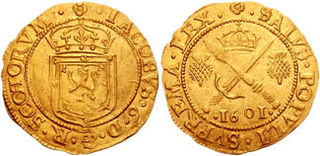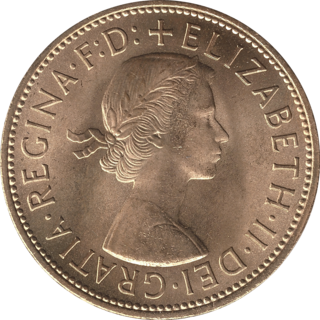A plack (Scottish Gaelic : plang) was an ancient Scottish coin of the value of four Scots pence or, by 1707, one-third of an English penny. [1]
James III of Scotland started minting placks and two pence half-placks in Edinburgh before 1473. They were made of "billon", an alloy with a low silver content. The name of the coin comes from a Flemish word for a metal disc. [2]
James IV of Scotland, who reigned from 1488 to 1513, issued two kinds of four pence placks, both minted in billon. The first issue has "Lombardic" mediaeval-style lettering, and the second issue used Roman capitals. There were also half-placks, valued at two pence. The half-placks are now comparatively rare. [3]
Placks issued during the minority years of James V are slightly different in design from those of his father, and are sometimes called "Queen's Placks", referring to his mother Margaret Tudor. No half-placks were minted under James V. [4]
Placks and other copper-based coins were widely counterfeited, and in May 1567 the Privy Council of Mary, Queen of Scots, prohibited the circulation of forgeries under the pain of treason. [5] An article considered by the Parliament of Scotland in December 1567 proposed the devaluation of the coins nonsunts, bawbees, placks, and hardheads, because of counterfeits or "false coins". [6]
In March 1574, Regent Morton issued a proclamation to "cry down" or devalue unofficial placks and lions or hardheads (two pence pieces) made in the time of Mary of Guise. The order was printed and published by John Ross. These placks would now be current at two pence, and the lions at one penny. The coins were to be returned to the mint, and if found lawful marked with a Douglas heart and star and returned to the owner. Such countermarked coins are often found today. The goldsmith James Gray was in charge of the marking. [7] The measure was intended to counter exorbitent prices and the large number of counterfeits. [8] [9] Morton's reform of the base money coinage was said to have caused hardship to the poor. [10]
A chronicle writer compared the motifs of the countermark, the "mark of a heart" with heraldry carved on Morton's Gate, the Portcullis Gate of Edinburgh Castle, and said that the labourers who worked on the reconstruction of the castle after the Marian Civil War had been paid with base money. [11]
In 1588 the word plack was also used to describe coins of the value of a penny or two pence, the "tuppences" having two dots placed next to the lion of Scotland. These twopenny placks are known as "hardheads" today. [12] Some contemporary counterfeits were made of copper blanks coated with tin, to give the appearance of billon. [13]
In July 1593 the Parliament of Scotland authorised the minting of a four penny plack with two sceptres crossed and a thistle. [14] This "saltire plack" was the last coin minted in billon alloy. [15]
A letter written by Robert Constable in 1569 described how English and Scottish rebels drank ale played cards for "placks and hardheads" at the house of Thomas Kerr of Ferniehirst in Jedburgh. [16]
The coin appears in the old song:
The word is probably derived from the ancient Flemish coin, a plaquette, in use before the introduction into the Netherlands of the French money reckoned by francs and centimes.
It can be found in the works of Robert Burns too:

The standard circulating coinage of the United Kingdom, British Crown Dependencies and British Overseas Territories is denominated in pennies and pounds sterling, and ranges in value from one penny sterling to two pounds. Since decimalisation, on 15 February 1971, the pound has been divided into 100 pence. Before decimalisation, twelve pence made a shilling, and twenty shillings made a pound.

A penny is a coin or a unit of currency in various countries. Borrowed from the Carolingian denarius, it is usually the smallest denomination within a currency system. At present, it is the formal name of the British penny (abbr. p) and the de facto name of the American one-cent coin (abbr. ¢) as well as the informal Irish designation of the 1 cent euro coin (abbr. c). Due to inflation, pennies have lost virtually all their purchasing power and are often viewed as an expensive burden to merchants, banks, government mints and the public in general.

The history of the English penny from 1603 to 1707 covers the period of the House of Stuart, up to the Acts of Union of 1707 which brought about the Union of the Kingdom of England with the Kingdom of Scotland.

Nemo me impune lacessit is the national motto of Scotland. It also served as the national motto of the historic Kingdom of Scotland prior to the Treaty of Union 1707.

The pound was the currency of Scotland prior to the 1707 Treaty of Union between the Kingdom of Scotland and the Kingdom of England, which created the Kingdom of Great Britain. It was introduced by David I, in the 12th century, on the Carolingian monetary system of a pound divided into 20 shillings, each of 12 pence. The Scottish currency was later devalued relative to sterling by debasement of its coinage. By the time of James III, one pound Scots was valued at five shillings sterling.

The merk is a long-obsolete Scottish silver coin. Originally the same word as a money mark of silver, the merk was in circulation at the end of the 16th century and in the 17th century. It was originally valued at 13 shillings 4 pence, later raised to 14s. Scots.
From c. 1124 until 1709 the coinage of Scotland was unique, and minted locally. A wide variety of coins, such as the plack, bodle, bawbee, dollar and ryal were produced over that time. For trading purposes coins of Northumbria and various other places had been used before that time; and since 1709 those of the Kingdom of Great Britain, and then of the UK.
A bodle or boddle or bodwell, also known as a half groat or Turner was a Scottish copper coin, of less value than a bawbee, worth about one-sixth of an English penny. They were first issued under Charles I, and were minted until the coronation of Anne. Its name may derive from Bothwell.

A bawbee was a Scottish sixpence. The word means a debased copper coin, valued at six pence Scots, issued from the reign of James V of Scotland to the reign of William II of Scotland. They were hammered until 1677, when they were produced upon screw presses.
The Penny Scots was a unit of the Pound Scots, the currency of Scotland until the Acts of Union 1707. The word "penny" was used in Scottish parlance for money generally; for example, a "penny-fee" was an expression for wages, a "penny-maister" would be a town treasurer, and a "penny-wedding" was one where every guest contributed to pay for the event. Meanwhile, "penny-wheep" was particularly poor beer.

The Act Anent the demission of the Crown in favour of our Sovereign Lord, and his Majesty's Coronation was an Act of the Parliament of Scotland passed on 12 December 1567. It confirmed the dethronement of Mary, Queen of Scots, in favour of her son, James VI.
Robert Richardson was a Scottish Prior of St Mary's Isle and royal administrator.

There were a number of mints in Scotland, for the production of the Scottish coinage. The most important mint was in the capital, Edinburgh, which was active from the reign of David I (1124–1153), and was the last to close, in the 19th century.

The Kingdom of Scotland was a sovereign state in northwest Europe, traditionally said to have been founded in 843. Its territories expanded and shrank, but it came to occupy the northern third of the island of Great Britain, sharing a land border to the south with the Kingdom of England. During the Middle Ages, Scotland engaged in intermittent conflict with England, most prominently the Wars of Scottish Independence, which saw the Scots assert their independence from the English. Following the annexation of the Hebrides and the Northern Isles from Norway in 1266 and 1472 respectively, and the capture of Berwick by England in 1482, the territory of the Kingdom of Scotland corresponded to that of modern-day Scotland, bounded by the North Sea to the east, the Atlantic Ocean to the north and west, and the North Channel and Irish Sea to the southwest.

The British pre-decimal penny was a denomination of sterling coinage worth 1⁄240 of one pound or 1⁄12 of one shilling. Its symbol was d, from the Roman denarius. It was a continuation of the earlier English penny, and in Scotland it had the same monetary value as one pre-1707 Scottish shilling. The penny was originally minted in silver, but from the late 18th century it was minted in copper, and then after 1860 in bronze.

Cornelius de Vos or de Vois or Devosse, was a Dutch or Flemish mine entrepreneur and mineral prospector working in England and Scotland. He was said to have been a "picture-maker" or portrait artist. De Vos is known for gold mining in Scotland and founding saltworks at Newhaven near Edinburgh.
John Acheson was a Scottish goldsmith, mining entrepreneur, and official of the mint.

James Cockie was a goldsmith in Edinburgh. He helped mint coins in Edinburgh Castle during the Marian Civil War and was hanged as a counterfeiter on 3 August 1573.

James Mosman or Mossman was a Scottish goldsmith. He and his son John Mosman were supporters of the cause of Mary, Queen of Scots. James Mosman was executed in 1573 for counterfeiting coins in Edinburgh Castle. John Mosman carried letters for Mary, Queen of Scots, and was under surveillance by Francis Walsingham.
James Gray was a Scottish goldsmith working in Edinburgh during the reigns of Mary, Queen of Scots and James VI of Scotland. Gray is known for the "Galloway mazer", a gilt cup now held by the National Museums of Scotland. He also engraved the brass plate for the tomb of Regent Moray in St Giles, Edinburgh.